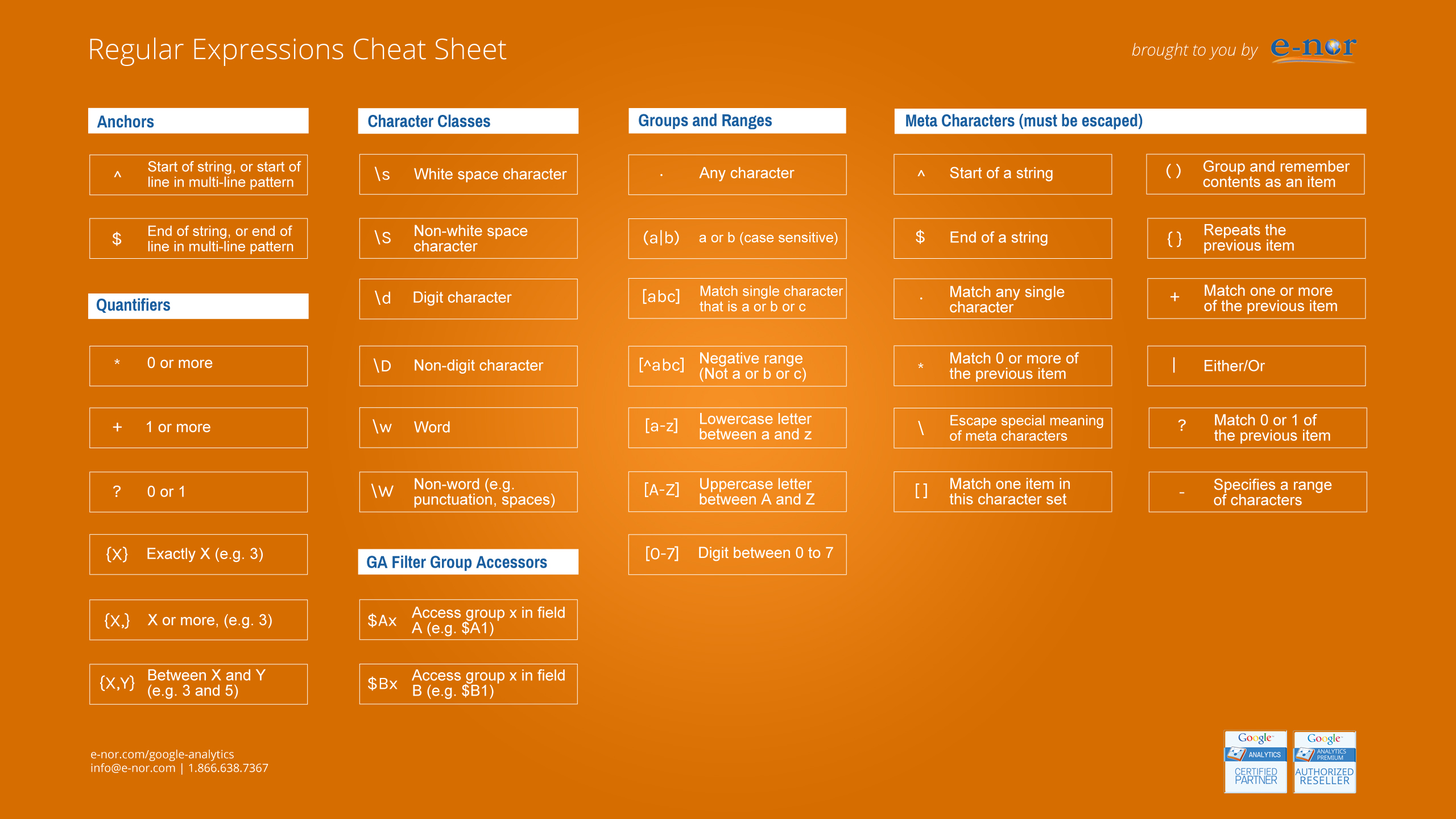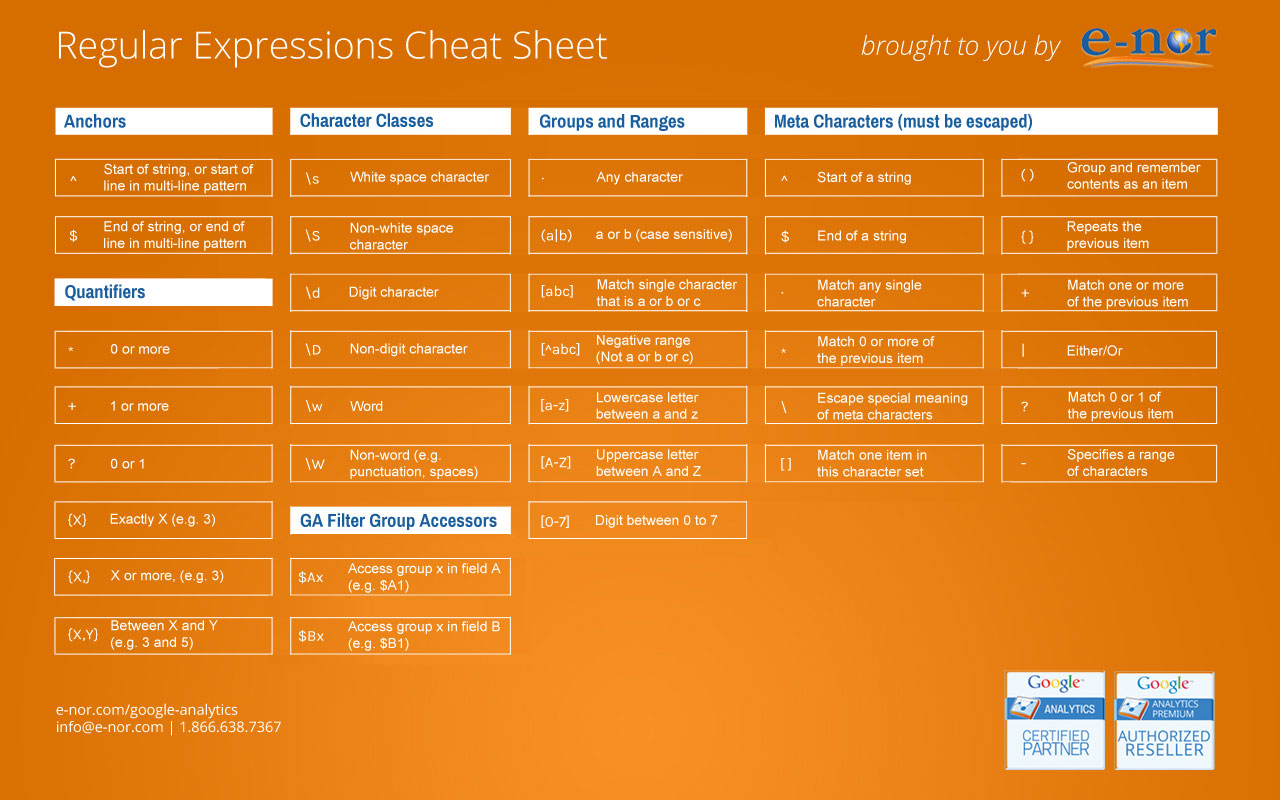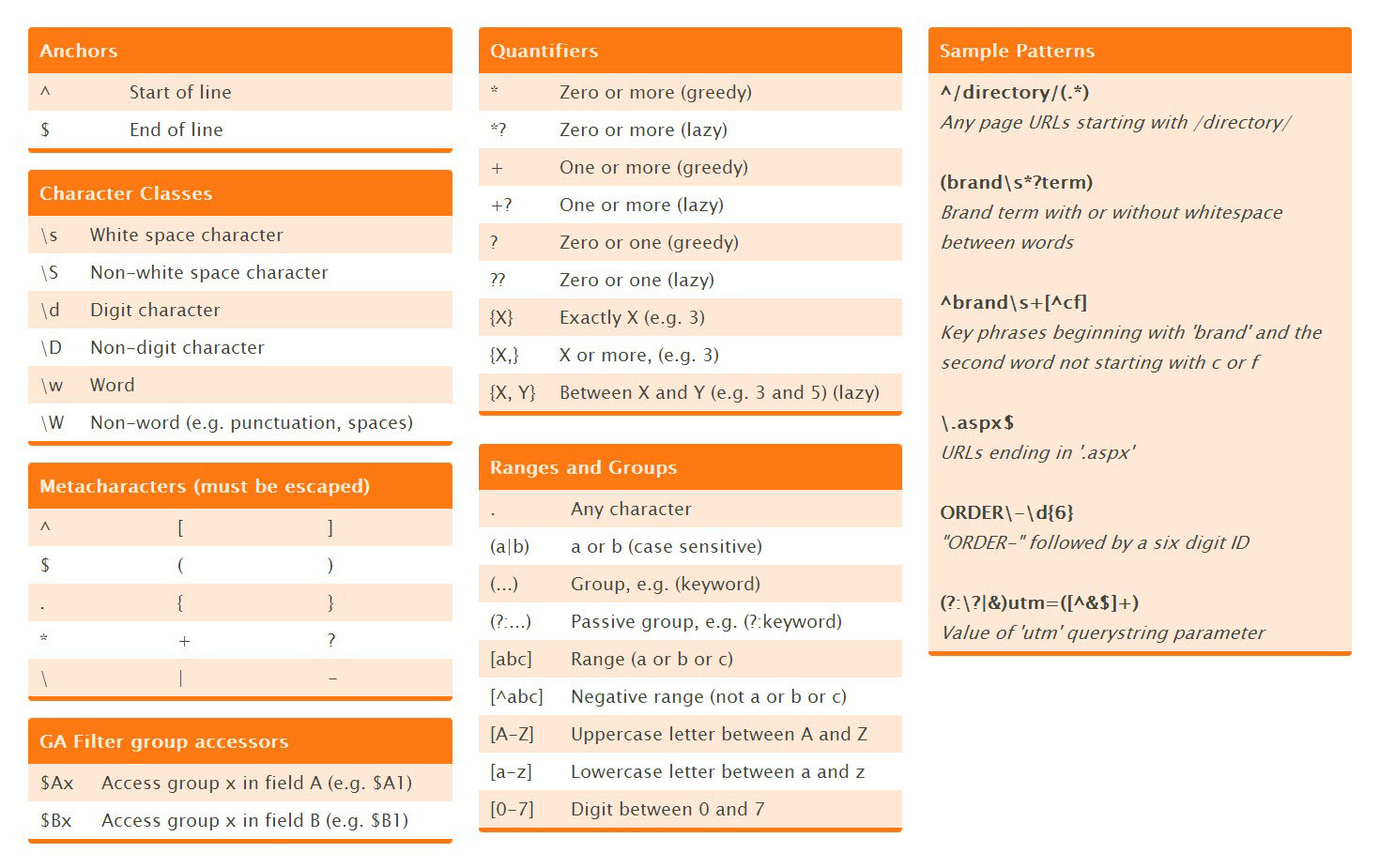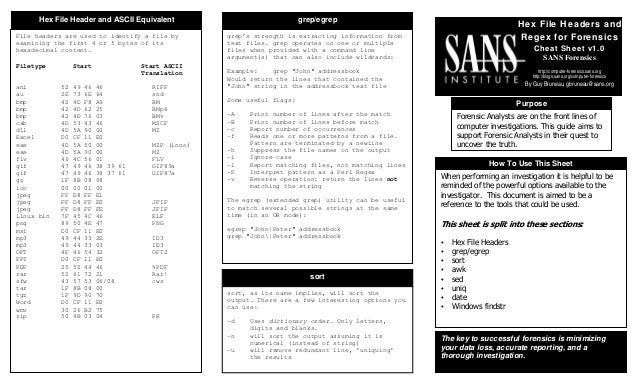Regex Cheat Sheet
Regular Expressions Cheat Sheet by DaveChild A quick reference guide for regular expressions (regex), including symbols, ranges, grouping, assertions and some sample patterns to get you started. Welcome to RegExLib.com, the Internet's first Regular Expression Library.Currently we have indexed 25935 expressions from 2982 contributors around the world. We hope you'll find this site useful and come back whenever you need help writing an expression, you're looking for an expression for a particular task, or are ready to contribute new expressions you’ve just figured out.
133HS IV3HD )3938 CHEAT SHEET THE ULTIMATE CHEAT SHEET FOR REGULAR EXPRESSIONS A super quick reference guide for regular expressions (regex), including symbols, ranges, grouping, assertions and some sample patterns to get you started. Anchors, or atomic zero-width assertions, specify a position in the string where a match must occur. When you use an anchor in your search expression, the regular expression engine does not advance through the string or consume characters; it looks for a match in the specified position only. For example, ^ specifies that the match must start at the beginning of a line or string. Therefore, the regular expression Ahttp: matches 'http:' only when it occurs at the beginning of a line. The following table lists the anchors supported by the regular expressions in the .NET Framework. ANCHORS Start of string, or start of line in multi-line pattern Start of string End of string, or end of line in multi-line pattern End of string Word boundary Not word boundary LA $ IZ b B Start of word 1> End of word ZINITH data Isystems CHARACTER CLASSES Character Classes in regular expressions match a selection of characters at once. For example, 'Id' will match any digit from 0 to 9 inclusive. 'w' will match letters and digits, and 'W' will match everything and digits. c Control character White space Not white space A pattern to indentify letters, numbers or whitespace could be: ws s IS Digit Not digit Word ld D Iw IW Not word Hexadecimal digit Octal digit POSIX Portable Operating System Interface for unix' is a [:upper:] [:lower:] [talpha:] [:alnum:] [:digit:] [:xdigit:] [:punct:] [:blank:] [space:] [:cntrl:] [:graph:] [:print:] [:word:] Upper case letters collection of standards that define some of the Lower case letters functionality that a (UNIX) operating system should support. One of these standards defines two flavors of regular expressions. Commands involving regular expressions, such as grep and egrep, implement these flavors on POSIX-compliant UNIX systems. Several database systems also use POSIX regular expressions All letters Digits and letters Digits Hexadecimal digits Punctuation Space and tab Blank characters Control characters Printed characters Printed characters and spaces Digits, letters and underscore ASSERTIONS IBM Assertions are tricky to get to grips with, but once you are familiar with them, you will use them alarmingly often. They provide a way to say 'I want to find out every word in this document with a q in it, as long as that q isn't followed by werty'. The above code starts by matching non-whitespace characters ([^s]*), then a q (err .. q). Then the parser reaches the lookahead assertion. This makes the q conditional. The q will only be matched if the assertion is true. In this case, the assertion is a negative assertion. It ?= Lookahead assertion ?! Negative lookahead [^s]'q{?!werty)[^s]* ?<= Lookbehind assertion Negative lookbehind Once-only Subexpression Condition [if then] Condition [if then else] ?!= or ? ?0 ?01 will be true if what it checks for is not found. ?# Comment Quantifiers allow you to specify a part of a pattem that must be matched a certain number of times. For example, if you QUANTIFIERS wanted to find out if a document contained between 10 and 20 (inclusive) of the letter 'a' in a row, you could use this pattern: a(10,20) Quantifier are 'greedy' by default. So the quantifier '+', which means 'one or more', will match as many items as possible. This can be a problem on occasion, so you can tell a quantifier to not be greedy (to be 'lazy'), using a modifier. Consider the following code: O or more {3} Exactly 3 1 or more {3,} 3 or more O or 1 {3,5} 3, 4 or 5 ? Add a ? to a quantifier to make it ungreedy. ESCAPE Regex use symbols to represent certain things. However, that presents a problem if you want to detect a character in a string where that character is a symbol. A period ('.') for example, in a regular expression, represents 'any character except the new line character'. If you want to find a period in a string, you can't just use '.' as a pattern - it will match just about everything. So, you need to tell the parser to treat the period as a literal period rather than a special character. Do with an escape character. S3DUBNÒ3S Escape following character Begin literal sequence End literal sequence Q E 'Escaping' is a way of treating characters which have a special meaning in regular expressions literally, rather than as special characters. SPECIAL CHARACTERS Special characters in regular expressions represent unusual elements in text. New lines and tabs, for example, can be typed using a keyboard, but are likely to trip up programming languages. The special characters use the escape character as well, to tell the regular expression parser that the following character is to be treated as a special character rather than a normal letter or number. In New line r Carriage return It Tab Iv Vertical tab f Form feed XxX Octal character xxX xhh Hex character hh 001000000I 9 B POVER A metacharacter is a special character in a COMMON META program or data field that provides information about other characters. It can express ideas on how to process the characters that follow the metacharacter, as the backslash character CHARACTERS sometimes is used to indicate that the charac- ters following it are to be treated in a special way. A common metacharacter usage is the wildcard character , which can represent any one character or any string of characters. 2$ { The escape character is usually R T V N GROUPS AND RANGES Groups and ranges are very very useful. Ranges are perhaps the easiest place to begin. They allow you to specify a selection of characters to match, Groups are essential to regular expressions, and are most often used when you want to use 'or' in a pattern, or you want to reference part of a pattern later in the same pattem, or where using regular expression string replacement. Any character except new line (n) a or b (alb) (...) (?:.) [abc] [^abc] [a-q] [A-Q] [0-7] Group Passive (non-capturing) group Range (a or b or c) Not a or b or c Lower case letter from a to q Upper case letter from A to Q Digit from 0 to 7 Group/subpattern number 'x' x PATTERN MODIFIERS Pattern modifiers are used in several languages, most notably Perl. These allow you to change how the parser works. For example, the 'i' modifier will tell the parser to ignore case. In Perl, regular expressions contain the same character at the beginning and end. This can be any character at all (often '/'), and is used like so: g Global match i* Case-insensitive Multiple lines Treat string as single line Allow comments and whitespace in pattern Evaluate replacement Ungreedy pattern m /pattern/ Modifiers would be added at the end of this, like so: s* e * /pattern/i U* PCRE modifier ZENITN data ISYstems STRING REPLACEMENT String replacement has already been covered above, however one small addition to note is the existence of 'passive' groups. These are groups that are ignored for the purposes of replacement. This is very useful when you want to match something that requires an 'or' section, but don't want it in the replacement. $n nth non-passive group 'xyz' in /^(abc(xyz))$/ 'xyz' in /^(?:abc)(xyz)$/ Before matched string After matched string Last matched string Entire matched string $2 $1 $ $ $+ $& Some regex implementations use instead of $. INFOGRAPHIC BY se up blog oda.com How to Build A Money Making Blog In 8 hours http://oxpandodramblings.com/indox.php/important-instagram-stats/ http://www.wikihow.com/Got-Followors-on-Instagram http://iphonephotographyschool.com/gain-followors-instagram/ http://www.huffingtonpost.com/global-yodol/how-to-got-moro-followors b_5511553.html https://blog.bufforapp.com/instagram-stats-instagram-tips http://blog.wishpond.com/pos/59138280816/47-tips-for-running-an-instagram-photo-contest http://www.slidoshare.net/TrackMaven/when-to-postslidesharepdf http://mashablo.com/2014/10/17/instagram-photos-infographic/
Writer
Category
AnimalsDid you work on this visual? Claim credit! Get a Quote
Get a Quote You may also like...
Cheat Sheet Regular Expression Math
Embed Code

For hosted site:
For wordpress.com:
Regular expressions are a very useful tool for developers. They allow to find, identify or replace a word, character or any kind of string. This tutorial will teach you how to master PHP regexp and show you extremely useful, ready-to-use PHP regular expressions that any web developer should have in his toolkit.
- Regular Expression Cheat Sheet - PCRE. Contribute to niklongstone/regular-expression-cheat-sheet development by creating an account on GitHub.
- Check out my REGEX COOKBOOK article about the most commonly used (and most wanted) regex 🎉 Regular expressions (regex or regexp) are extremely useful in extracting information from any text.
Getting Started With Regular Expressions
For many beginners, regular expressions seem to be hard to learn and use. In fact, they’re far less hard than you may think. Before we dive deep inside regexp with useful and reusable codes, let’s quickly see the basics of PCRE regex patterns:
Regular Expressions Syntax
A regular expression (regex or regexp for short) is a special text string for describing a search pattern. A regex pattern matches a target string. The following table describes most common regex:
| Regular Expression | Will match… |
|---|---|
| foo | The string “foo” |
| ^foo | “foo” at the start of a string |
| foo$ | “foo” at the end of a string |
| ^foo$ | “foo” when it is alone on a string |
| [abc] | a, b, or c |
| [a-z] | Any lowercase letter |
| [^A-Z] | Any character that is not a uppercase letter |
| (gif|jpg) | Matches either “gif” or “jpg” |
| [a-z]+ | One or more lowercase letters |
| [0-9.-] | Any number, dot, or minus sign |
| ^[a-zA-Z0-9_]{1,}$ | Any word of at least one letter, number or _ |
| ([wx])([yz]) | wy, wz, xy, or xz |
| [^A-Za-z0-9] | Any symbol (not a number or a letter) |
| ([A-Z]{3}|[0-9]{4}) | Matches three letters or four numbers |
PHP Regular Expression Functions
PHP has many useful functions to work with regular expressions. Here is a quick cheat sheet of the main PHP regex functions. Remember that all of them are case sensitive.
For more information about the native functions for PHP regular expressions, have a look at the manual.
| Function | Description |
|---|---|
| preg_match() | The preg_match() function searches string for pattern, returning true if pattern exists, and false otherwise. |
| preg_match_all() | The preg_match_all() function matches all occurrences of pattern in string. Useful for search and replace. |
| preg_replace() | The preg_replace() function operates just like ereg_replace(), except that regular expressions can be used in the pattern and replacement input parameters. |
| preg_split() | Preg Split (preg_split()) operates exactly like the split() function, except that regular expressions are accepted as input parameters. |
| preg_grep() | The preg_grep() function searches all elements of input_array, returning all elements matching the regex pattern within a string. |
| preg_ quote() | Quote regular expression characters |
Validate a Domain Name
Case sensitive regex to verify if a string is a valid domain name. This is very useful when validating web forms.
» Source
Enlight a Word From a Text
This very useful regular expression will find a specific word in a string and enlight it. Extremely useful for search results. Remember that it’s case sensitive.
» Source
Enlight Search Results in Your WordPress Blog
The previous code snippet can be very handy when it comes to displaying search results. If your website is powered by WordPress, here is a more specific snippet that will search and replace a text by the same text within an HTML tag that you can style later, using CSS.
Open your search.php file and find the the_title() function. Replace it with the following:
Now, just before the modified line, add this code:
Save the search.php file and open style.css. Append the following line to it:
» Source
Get All Images From a HTML Document
If you ever wanted to be able to get all images form a webpage, this code is a must have for you. You should easily create an image downloader using the power of cURL.
» Source
Remove Repeated Words (Case Insensitive)
Often repeating words while typing? This handy case insensitive PCRE regex will be very helpful.
» Source
Remove Repeated Punctuation
Same php regex as above, but this one will look for repeated punctuation within a string. Goodbye multiple commas!

» Source
Match a XML/HTML Tag
This simple function takes two arguments: The first is the tag you’d like to match, and the second is the variable containing the XML or HTML. Once again, this can be very powerful used along with cURL.
Match an HTML/XML Tag With a Specific Attribute Value
This function is very similar to the previous one, but it allow you to match a tag having a specific attribute. For example, you could easily match <div>.
Match Hexadecimal Color Values
Another interesting tool for web developers! It allows you to match/validate a hexadecimal color value.
Find Page Title
Cheat Sheet Regular Expression Pdf
This handy code snippet will find and print the text within the <title> and </title> tags of a HTML page.
Parse Apache Logs
Most websites are running on the Apache webserver. If your website does, you can easily use PHP and regular expressions to parse Apache logs.
» Source
Replace Double Quotes by Smart Quotes

If you’re a typography lover, you’ll probably love this regex pattern which allow you to replace double quotes by smart quotes. A similar regular expression is used by WordPress to make the content more beautiful.
» Source
Check Password Complexity
This regular expression will tests if the input consists of 6 or more letters, digits, underscores, and hyphens.
The input must contain at least one uppercase letter, one lowercase letter and one digit.
» Source
WordPress: Using Regexp to Retrieve Images From a Post
As I know many of you are WordPress users, you’ll probably enjoy that code which allows you to retrieve all images from post content and display it.
To use this code on your blog, simply paste the following code on one of your theme files.
Generate Emoticons Automatically
Another function used by WordPress. This one allow you to automatically replace an emoticon symbol by an image.
